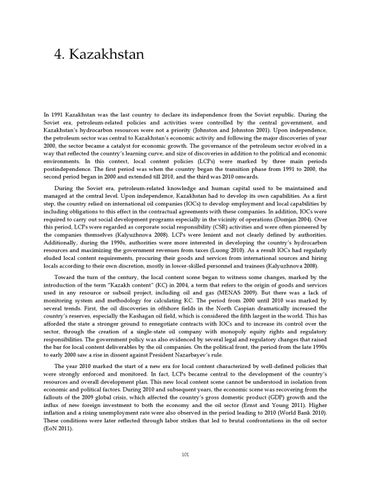4. Kazakhstan
In 1991 Kazakhstan was the last country to declare its independence from the Soviet republic. During the Soviet era, petroleum-related policies and activities were controlled by the central government, and Kazakhstan’s hydrocarbon resources were not a priority (Johnston and Johnston 2001). Upon independence, the petroleum sector was central to Kazakhstan’s economic activity and following the major discoveries of year 2000, the sector became a catalyst for economic growth. The governance of the petroleum sector evolved in a way that reflected the country’s learning curve, and size of discoveries in addition to the political and economic environments. In this context, local content policies (LCPs) were marked by three main periods postindependence. The first period was when the country began the transition phase from 1991 to 2000, the second period began in 2000 and extended till 2010, and the third was 2010 onwards. During the Soviet era, petroleum-related knowledge and human capital used to be maintained and managed at the central level. Upon independence, Kazakhstan had to develop its own capabilities. As a first step, the country relied on international oil companies (IOCs) to develop employment and local capabilities by including obligations to this effect in the contractual agreements with these companies. In addition, IOCs were required to carry out social development programs especially in the vicinity of operations (Domjan 2004). Over this period, LCPs were regarded as corporate social responsibility (CSR) activities and were often pioneered by the companies themselves (Kalyuzhnova 2008). LCPs were lenient and not clearly defined by authorities. Additionally, during the 1990s, authorities were more interested in developing the country’s hydrocarbon resources and maximizing the government revenues from taxes (Luong 2010). As a result IOCs had regularly eluded local content requirements, procuring their goods and services from international sources and hiring locals according to their own discretion, mostly in lower-skilled personnel and trainees (Kalyuzhnova 2008). Toward the turn of the century, the local content scene began to witness some changes, marked by the introduction of the term “Kazakh content” (KC) in 2004, a term that refers to the origin of goods and services used in any resource or subsoil project, including oil and gas (MENAS 2009). But there was a lack of monitoring system and methodology for calculating KC. The period from 2000 until 2010 was marked by several trends. First, the oil discoveries in offshore fields in the North Caspian dramatically increased the country’s reserves, especially the Kashagan oil field, which is considered the fifth largest in the world. This has afforded the state a stronger ground to renegotiate contracts with IOCs and to increase its control over the sector, through the creation of a single-state oil company with monopoly equity rights and regulatory responsibilities. The government policy was also evidenced by several legal and regulatory changes that raised the bar for local content deliverables by the oil companies. On the political front, the period from the late 1990s to early 2000 saw a rise in dissent against President Nazarbayev’s rule. The year 2010 marked the start of a new era for local content characterized by well-defined policies that were strongly enforced and monitored. In fact, LCPs became central to the development of the country’s resources and overall development plan. This new local content scene cannot be understood in isolation from economic and political factors. During 2010 and subsequent years, the economic scene was recovering from the fallouts of the 2009 global crisis, which affected the country’s gross domestic product (GDP) growth and the influx of new foreign investment to both the economy and the oil sector (Ernst and Young 2011). Higher inflation and a rising unemployment rate were also observed in the period leading to 2010 (World Bank 2010). These conditions were later reflected through labor strikes that led to brutal confrontations in the oil sector (EoN 2011).
101
